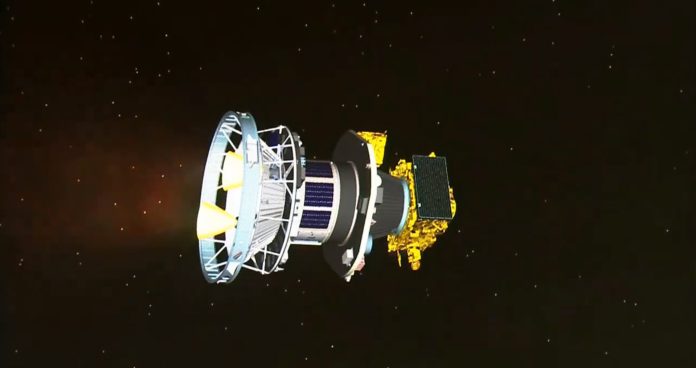Sriharikota: PSLV-C58 XPoSat Mission launch | ISRO launches X-Ray Polarimeter Satellite (XPoSat) from the first launch-pad, SDSC-SHAR, Sriharikota in Andhra Pradesh.
On PSLV-C58 XPoSat mission, ISRO Chief S Somanath says “So 1, January 2024, yet another successful mission of PSLV has been accomplished…”
#WATCH | On PSLV-C58 XPoSat mission, ISRO Chief S Somanath says "So 1, January 2024, yet another successful mission of PSLV has been accomplished…" pic.twitter.com/VwFCmRxvOU
— ANI (@ANI) January 1, 2024
The PSLV-C58 rocket carrying primary payload XPoSat and 10 other satellites will lift off at 9.10am from the Satish Dhawan Space Centre in Sriharikota.
The Indian Space Research Organisation (ISRO) is set to usher in the New Year with the launch of India’s maiden dedicated polarimetry mission, the X-Ray Polarimeter Satellite (XPoSAT). This mission aims to study the diverse dynamics of bright astronomical X-ray sources in extreme conditions, providing insights into celestial objects like black holes. The launch is scheduled to take place on Monday morning, utilizing a Polar Satellite Launch Vehicle (PSLV) rocket. This milestone follows the success of ISRO’s Gaganyaan Test Vehicle D1 mission in October.
The PSLV-C58 rocket, in its 60th mission, will carry primary payload XPoSat and 10 other satellites to be deployed in low earth orbits. Four Indian space startups will launch their payloads to demonstrate microsatellite subsystems, thrusters or small engines that keep satellites in desired orbits, and radiation shield coating for satellites onboard the PSLV-C58 mission.
Top points on ISRO’s XPoSat launch
- The 25-hour countdown began on Sunday for the lift-off scheduled at 9.10am from the first launch pad at this spaceport, located about 135 km east of Chennai, on January 1. “The countdown commenced for PSLV-C58 at 8.10 am,” ISRO sources told new agency PTI on Sunday.
- The XPoSat has been designed to investigate the polarisation of intense X-ray sources in space.
- The 44.4-meter-tall PSLV rocket would first deploy the primary satellite into a 650 km Low Earth Orbit around 21 minutes after lift-off and later the scientists would bring the satellite to a lower altitude of about 350 km by restarting the fourth stage of the vehicle, for conducting the PSLV Orbital Experimental Module-3 (POEM-3) experiment.
- According to the ISRO, the spacecraft will carry two scientific payloads in a low earth orbit. The primary payload POLIX (Polarimeter Instrument in X-rays) will measure the polarimetry parametres (degree and angle of polarisation) in the medium X-ray energy range of 8-30 keV photons of astronomical origin. The XSPECT (X-ray Spectroscopy and Timing) payload will give spectroscopic information in the energy range of 0.8-15 keV.
- The emission mechanism from various astronomical sources such as black hole, neutron stars, active galactic nuclei, pulsar wind nebulae, etc. originates from complex physical processes and are challenging to understand, the ISRO said.
- While the spectroscopic and timing information by various space-based observatories provides a wealth of information, the exact nature of the emission from such sources still poses deeper challenges to astronomers.
- “The polarimetry measurements add two more dimensions to our understanding, the degree of polarization and the angle of polarization and thus is an excellent diagnostic tool to understand the emission processes from astronomical sources. The polarimetric observations along with spectroscopic measurements are expected to break the degeneracy of various theoretical models of astronomical emission processes. This would be the major direction of research from XPoSat by the Indian science community,” the ISRO said.
- Besides the ISRO, the US-based National Aeronautics Space Agency (NASA) conducted a similar study – the Imaging X-Ray Polarimetry Explorer mission in December 2021 on the remnants of supernova explosions, the particle streams emitted by black holes and other cosmic events.
- The mission life is about 5 years. XPoSat is anticipated to bring substantial benefits to the astronomy community globally.
- Hyderabad-based Dhruva Space will validate the functionality and robustness of the P-30 nanosatellite platform and its various subsystems in-orbit as part of ‘Launching Expeditions for Aspiring Payloads – Technology Demonstrator’ (LEAP-TD) payload on the PSLV-C58 mission that will launch the XPoSat satellite. The payloads of the space-tech start-ups and other research institutions will be housed on the fourth stage of the PSLV rocket that will be placed in a low earth orbit for carrying out various experiments.

